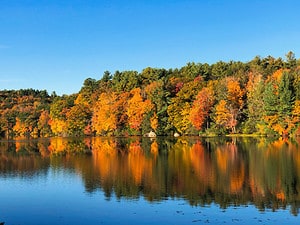When was the last time you consciously chose to spend time in nature? Was it a stroll through the city park or a day hike in the wilderness? Thanks to the global trend towards urban living and limitless screen time, many people miss out on the numerous benefits of being in contact with nature.
From brilliant rainbows, and pristine beaches to golden sunsets and gushing geysers, the Earth never ceases to display natural wonders. It’s up to you to discover them because they are particularly abundant in the United States.
The majority of the world’s 1,000 geysers are found close to volcanoes. According to UNESCO, there are more geysers at Yellowstone National Park than anywhere else in the world. The park was designated a World Heritage Site in 1978.
There are also about 200 of them on the Kamchatka Peninsula in the Russian Far East, 40 in New Zealand, 16 in Iceland, and 50 elsewhere in various other volcanic areas. Is it worthwhile to visit any of them? Yes, without a doubt!
Witnessing a geyser erupt, is an absolutely breathtaking experience that you should not miss.
What is a Geyser?
A geyser is an uncommon hot spring that erupts a mixture of turbulent water and steam at regular intervals. By implication, geysers need to be heated and filled with water continuously. Therefore, the majority are found in regions with active volcanism, and in regions with abundant rainfall or snowfall. Volcanoes provide heat, and rain and snow provide water. Many geysers are found in clusters known as geyser fields. Here, the eruption of one geyser may have an impact on the behavior of nearby ones, making them less frequent or more erratic.
Underground spaces with the capacity to build pressure, steam, and water are also necessary for geysers. Water would simply gurgle up steadily and quietly in a hot spring if there were no such gaps.
A sudden, turbulent discharge is then caused by an interaction between temperature and pressure. These develop over time in the underground spaces that allow fluid and gas to build up.

A geyser is an uncommon hot spring that erupts a mixture of turbulent water and steam at regular intervals.
©Susanne Pommer/Shutterstock.com
How Does a Geyser Erupt?
A deep hole in the Earth’s surface that resembles a tube is what gives rise to geysers. Once the tube is filled with water, the magma, which is located close to the bottom of the tube, heats the water.
Near the magma in the lower portion of the tube, the water gets extremely hot. It gradually starts to boil. Then, the steaming or gasification of the boiling water starts. Steam shoots up to the surface. The water column above it is ejected by its strong steam jet. Water pours quickly through the tube and into the atmosphere.
The eruption will go on until either all the water is forced out of the tube or the geyser’s temperature drops below boiling point. Water gradually flows back into the tube, following the eruption and the cycle starts all over again. While the eruption process can occur in some small geysers in a matter of minutes, it may take days for larger geysers.
The Largest Geysers in the US and How to See Them
Geysers are such a geologic wonder to behold. It’s not surprising, therefore, that the Yellowstone National Park, which houses the world’s most famous geyser, records 4 million visitors annually.
Old Faithful, Wyoming
The southwest corner of Yellowstone Park, in the Upper Geyser Basin, is where you can find Old Faithful. Its eruptions can be as high as 100 to 180 feet, with an average height of 130 to 140 feet.
Currently, the most iconic geyser in Yellowstone Park erupts around 20 times a day with a typical interval lasting between 60 and 110 minutes.
You might be wondering if the Old Faithful is still faithful. Well, this depends on who you ask. Before the earthquake of 1959, Old Faithful erupted 21 times daily which represents a sharp drop in activity for geologists monitoring each eruption.
Depending on how long an eruption lasts, scientists have estimated that between 3,700 gallons (for a brief period of 1.5 minutes) and 8,400 gallons (for a longer duration of 4.5 minutes) of water may be released.
Keep in mind that a temperature of 204°F (95.6°C) has been recorded at the vent during an eruption while the steam is hotter than 350°F.
It costs $35 to enter Yellowstone and see Old Faithful. Autos, recreational vehicles, and motorcycles all pay the same $30 fee. You also get to discover the other parts of the park because the pass is valid for seven days after entry.
Bonus point: visit Yellowstone during the winter or shoulder season for a more private viewing of Old Faithful.
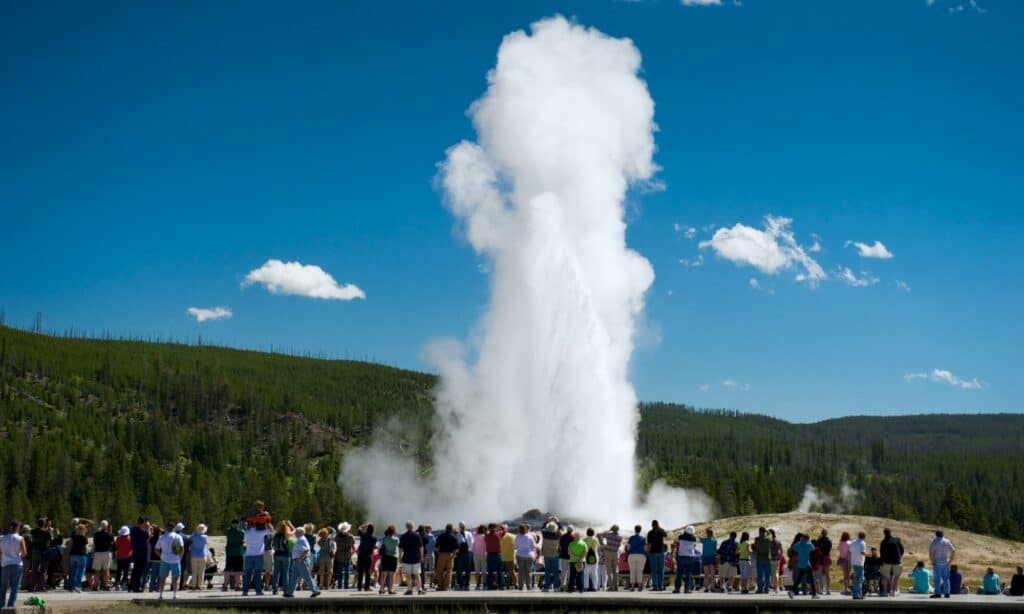
Tourists gather to watch as Old Faithful geyser in Yellowstone National Park erupts forcing out boiling water and steam from the bedrock below.
©iStock.com/BigshotD3
Fly Ranch Geyser, Nevada
Aside from the Las Vegas Strip, Nevada is home to a lesser-known natural wonder that could be regarded as the most colorful geyser in the world. Situated on the privately owned Fly Ranch in the Black Rock Desert, Washoe County of Nevada, the six-foot-tall geothermal geyser expels boiling water into the air, occasionally rising as high as five feet.
Do you know how the desert wonder got its bright colors? The multicolored appearance is caused by thermophilic algae that grow on calcium carbide. Although the algae can only grow in hot, humid conditions.
This one-of-a-kind natural wonder is a must-see for anyone visiting Nevada, but it is currently closed to the public. What an irony, isn’t it? Not to worry, there is a workaround. You can book a guided tour of the Fly Geyser thanks to a collaboration between Friends of Black Rock-High Rock and the Burning Man Project.
Got your tickets? Visit the Friends of Black Rock-High Rock Visitor Center Store at 320 Main Street, Gerlach, Nevada 89412. You can then carpool to the geyser and have an awe-inspiring experience.
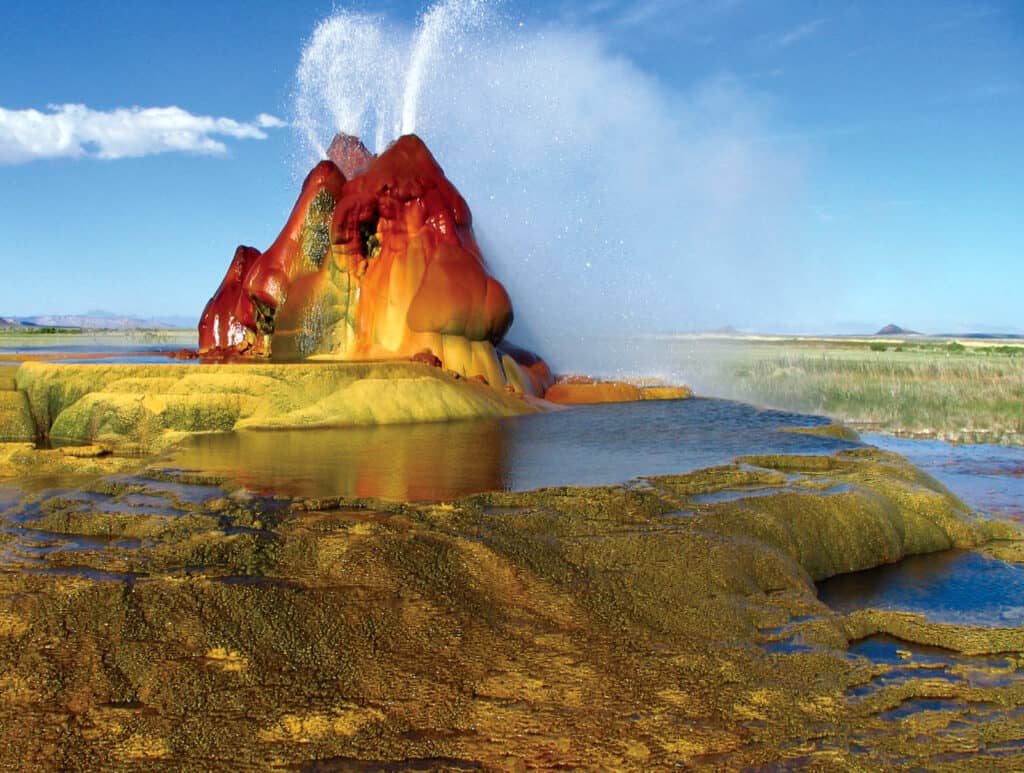
Situated on the privately owned Fly Ranch in the Black Rock Desert, Washoe County of Nevada, the six-foot-tall geothermal geyser expels boiling water into the air, occasionally rising as high as five feet.
©(1,600 × 1,208 pixels, file size: 796 KB, MIME type: image/jpeg) – License
Old Perpetual Geyser, Oregon
The only geyser in the Pacific Northwest is located in Lakeview Town, Oregon. Every 90 seconds, this geyser shoots water that plumes more than 60 feet into the air.
In June 2009, the geyser stopped eruptions as a result of the town’s nearby geothermal development for the Warner Creek Correctional Facility’s hot water supply. The entire network of hot springs and wetlands is now in danger due to the further development of the geothermal power generation site. However, Old Perpetual started to erupt on a regular basis again in May 2015.
The Old Perpetual viewing area is accessible to the general public, and guests have access to a mineral pool.
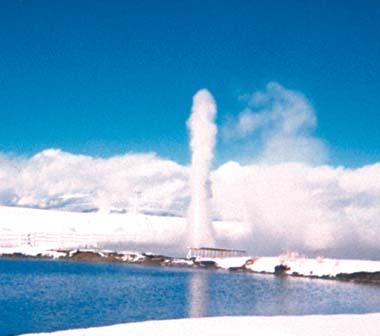
The only geyser in the Pacific Northwest is located in Lakeview Town, Oregon.
© (380 × 336 pixels, file size: 23 KB, MIME type: image/jpeg) – License
Morning Glory Geyser, Wyoming
Better known as Morning Glory Pool, this is one of the most popular geysers in the Upper Geyser Basin of Yellowstone Park and it’s reachable from the Old Faithful Visitor Center at the end of a straight 1.5-mile trail. The bacteria that live in the pool are responsible for its famous rainbow waters.
Due to the pool’s sporadic eruptions in response to earthquakes and other seismic activity, it is occasionally referred to as a geyser. It’s quite unfortunate that the pool loses its lovely colors because of the objects thrown into the spring. These items obstruct the thermal vents in the pool, which lowers the temperature and kills the thriving bacteria that live there.
Expect to pay $35 for an entrance pass because it is within Yellowstone Park, compared to $30 for motorcycles, cars, and recreational vehicles.
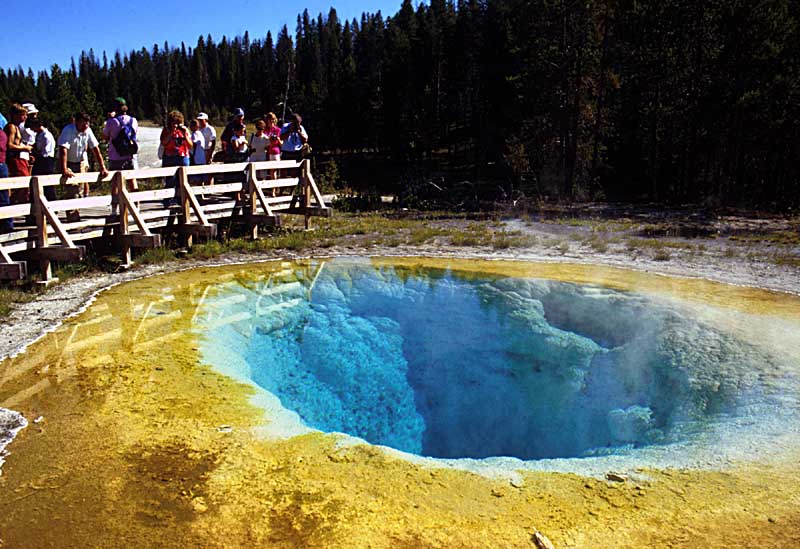
The bacteria that live in the pool are responsible for its famous rainbow waters.
©(800 × 549 pixels, file size: 100 KB, MIME type: image/jpeg) – License
Steamboat Geyser, Wyoming
Yellowstone has proven to be the world’s largest concentration of geysers. Located in the park’s northwest corner in the Norris Geyser Basin is the tallest geyser in the world.
The Steamboat Geyser shoots water 380 feet into the air. Only the Waimangu Geyser in New Zealand has reached higher eruptions, but not in more than a century.
Only the Excelsior Geyser in Midway Geyser Basin and Sapphire Pool in Biscuit Basin have ever been larger than the Steamboat in the recorded history of America’s first national park.
Another unique thing about this geyser is that the eruption schedule is unpredictable. It was dormant from 1911 to 1961, but the geyser has been erupting fairly often ever since.
The $35 Yellowstone entrance fee is also applicable when going to see the Steamboat. The best part? The ticket remains valid for seven days.
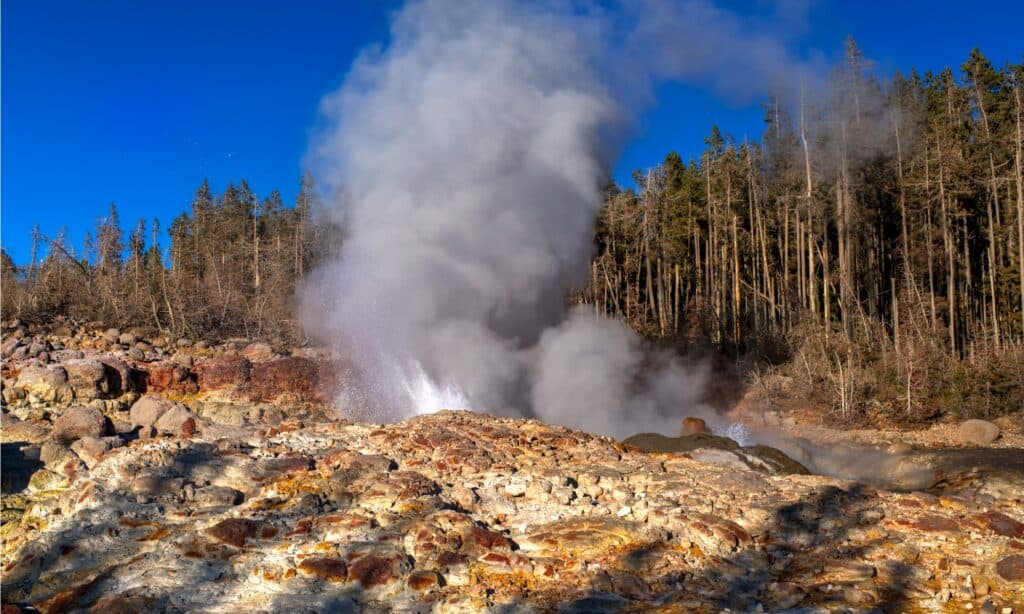
The Steamboat Geyser shoots water 380 feet into the air.
©iStock.com/SergeYatunin
Up Next…
Check out our other articles about Earth’s magnificent wonders.
- Volcanos vs Geysers – You can finally find out what the real differences are.
- Yellowstone National Park – A complete guide so you know exactly what to expect.
- Earthquakes – Read on to find out what they are and why they happen.
The photo featured at the top of this post is © Susanne Pommer/Shutterstock.com
Sources
- Only In Your State, Available here: https://www.onlyinyourstate.com/usa/geysers-incredible-usa/
- National Geographic, Available here: https://education.nationalgeographic.org/resource/geyser
- Britannica, Available here: https://www.britannica.com/science/geyser
- Unesco, Available here: https://whc.unesco.org/en/list/28
- Yellowstone Park, Available here: https://www.yellowstonepark.com/things-to-do/geysers-hot-springs/about-old-faithful
- USGS, Available here: https://www.usgs.gov/observatories/yvo/news/whats-story-morning-glory
- Knowable Magazine, Available here: https://knowablemagazine.org/article/physical-world/2018/thar-she-blows-what-why-and-where-geysers
FAQs (Frequently Asked Questions)
Do geysers have uses?
There are many uses for geysers, including the generation of electricity, heating, and tourism.
Is a geyser the same as a volcano?
No. As opposed to volcanoes, which spew out rock and ash, geysers release water and steam. Also, geysers erupt quite often and are physically much smaller than volcanoes.
What other countries have geysers?
Apart from the United States, you can find geysers in New Zealand, Chile, Iceland, and Russia.
Are there geysers beyond Earth?
Yes. Both the moons of Saturn and Neptune, Enceladus and Triton, erupt mixtures of solids and gas from their icy surfaces occasionally. The energy source on Triton appears to be sunlight that is heating the surface from above and creating jets that could be made of nitrogen. On Enceladus, the tides brought on by Saturn’s gravity cause the outer ice shell to flex and create rifts.
Thank you for reading! Have some feedback for us? Contact the AZ Animals editorial team.





